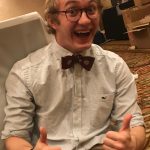 Samuel Warren
Samuel WarrenHome Institution: Yale University
Status: Sophomore, Expected Graduation Date: May 2020
Field of Study: Majoring in Chemistry, Physics, and Mathematics
Host Lab in Japan: Kyushu University – Measurement and Instrument Lab, Kiss Laboratory
Host Professor: Prof. Takanobu Kiss
Research Project: Scanning Hall Probe Microscopy Analysis of Critical Current Density in Superconducting Materials (PDF)
Why Nakatani RIES?
I think my first experience with Japanese culture came in the form of a laser beam breathing nuclear lizard fighting an irradiated moth, and since then I’ve been hooked. I learned about the Nakatani RIES Fellowship from my first-year chemistry professor and was immediately interested because of the opportunity to both explore a new country and to engage in cutting edge research. I have spent some time traveling in foreign countries, but I have never worked abroad. While being a tourist does allow for a relaxing time in another country, I think working overseas will allow me to really delve into Japanese culture. I was attracted to the program because of the emphasis it places on learning about Japanese culture, and if everything goes as planned, I’ll walk away knowing how to make pufferfish sashimi.
The Nakatani RIES program was also enticing because a large number of the prospective labs that deal with green energy issues such as greater efficiency in energy usage, and more effective solar energy production. I find these issues extremely interesting, and I think that the Nakatani program does a great deal towards facilitating international conversations about environmental issues, which is essential for a sustainable future. I am looking forward to participating in this program and in these conversations about humanity’s sustainable future.
Goals for the Summer
- Gain basic fluency in Japanese
- Learn to prepare raw fish
- Experience applications-based research and experimentation
- Develop friendships and future research opportunities
Meaning of Nakatani RIES: Post-Program
I think the Nakatani Program was meaningful because it introduced me to a part of the world and specifically Japan I probably never would have gone to. I don’t think many people visiting Japan go to I don’t think many people visiting Japan to to Kyushu and fewer people actually live out in farmland. Where I lived was one of the prettiest locations I have ever been, but it was also extremely isolated.
Daily Life in the Lab
In my research I used a scanning hall probe microscope to measure the critical current densities in several superconducting materials. This was the only type of experiment I did, and I believe I only did it 5 times. The vast majority of the time I spent watching youtube videos or teaching myself how to code. Most people worked from about 11-7 most days, and everyone was very friendly although only two people in my lab could almost speak conversational English. We had two lab parties at the beginning and end of my stay at the lab, although probably the most fun I had with the lab was when Sarah, Kono-sensei, and Ogawa-san visited and we all went out with Professor Kiss.
The walk to the lab takes about 15 minutes, but I think there is a bus once every hour or maybe every other hour (except on the weekends when they are much less often). I would then spend the next couple of hours reading the NYtimes or the Economist. After eating lunch with the French exchange student, Nicolas, I would go back to lab and start working on coding. Dinner would normally consist of ramen and an egg, then I would go to the climbing gym for 3 hours. Finally, I would shower and go to bed. One of my favorite trips was to Nagasaki, I met a bunch of really cool people in an Izakaya, and had a great time with them. I also really enjoyed biking and exploring the beaches surrounding Itoshima (some of the prettiest in the country).
- My favorite experience in Japan was… hiking in the mountains on a rainy day, and experiencing several acts of kindness from strangers along the way.
- Before I left for Japan I wish I had … more thoroughly planned out my weekend trips.
- While I was in Japan I wish I had swam to some islands … but I was really afraid of the jellyfish, and other scary ocean creatures.
Excerpts from Samuel’s Weekly Reports
- Week 01: Arrival in Japan
- Week 02: Language Learning & Trip to Mt. Fuji Lakes
- Week 03: Noticing Similarities, Noticing Differences
- Week 04: First Week at Research Lab
- Week 05: Cultural Analysis – Life in Japan
- Week 06: Cultural Analysis – In the Lab
- Week 07-08: Overview of Mid-Program Meeting & Research Host Lab Visit
- Week 09: Research in Japan vs. Research in the U.S.
- Week 10: Reflections on Japanese Language Learning
- Week 11: Interview with a Japanese Researcher
- Week 12-13: Final Week at Research Lab & Re-Entry Program
- Final Research Poster & Project Overview
- Follow-on Project
- Tips for Future Participants
Week 01: Arrival in Japan
Before arriving in Japan even before I reached Rice’s campus, I was reminded of my inability to learn foreign languages. As I got up from eating a taco in GW airport, a Hispanic cleaning lady mopping near me started to tell me I didn’t need to leave. Unfortunately, despite studying Spanish for a combined total of 8 years I was unable to communicate that I was leaving to grab my bags not because of her. My only thought was this bodes well for me all alone in Kyushu.
Before leaving for Tokyo, we were given a talk about the importance of creating a stylish research poster, it was during this talk that I realized I would need a lot of help. I don’t know if it is a result of my colorblindness or my southern desire to always wear pastel clothing, but I have never been one to be particularly stylish or artistic. Regardless, the talk convinced me to avoid making my poster look like the American flag and to practice less winding sentences for clearer communication. (lol)
During the pre-orientation it was also reassuring to see that not everyone spoke fluent Japanese and some were still learning their Kana. However, perhaps the best experience was talking to the students who had done the program before and listening to their advice and stories. I think the main idea they tried to impress on us, was that research is hard and almost never works out so don’t get too stressed. I hope I can remember that when the time to create my research poster comes around.
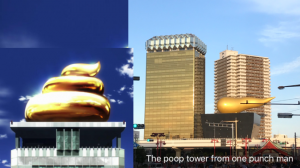
When we first arrived in Tokyo it was everything I expected: grey, raining, and claustrophobic. I am not a huge fan of big cities. Everyone is always in a rush, people are impolite, smiling at people is weird, the huge buildings make you feel insignificant (but not in the same way mountains do), and everything is so expensive. Right after we arrive at the hotel, we go to a restaurant where a tall Japanese man looks irate at the group of foreigners who walked in, and I melancholically stared at the rainy Blade Runner surroundings (everyone was walking around with clear umbrellas and rain coats). When we got back to the hotel, I was pretty soaked and cold, luckily my life was about to be transformed. It was time for the Sentō. The relaxing bath along with a funny conversation with an older gentleman from Kyushu really made my day 10000% better. I have since gone to the sentō every day because you never know who you are going to see. Also, in a country where it is so clearly obvious you are a foreigner and everyone treats you like one (giving you extra space on the subway or condescendingly staring at you) it feels good to be accepted in the sentō. Everyone gets in the bath, everyone relaxes, everyone is nude, and everyone is participating in this ancient tradition of communal bathing. It is at its core a community activity and being able to join in the bath is like joining the community.
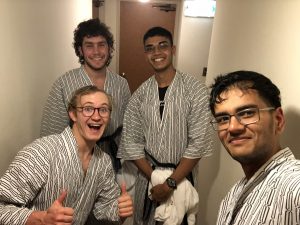
Japanese classes have been very interesting because we have had a different teacher every single day. My first theory was that they didn’t want us getting used to only one accent, and I can confidently say I don’t understand each one equally. All of the teachers have been very encouraging, and I can almost pronounce gozaimashita without sounding like I’m talking about a toilet. The grammar is becoming slightly less elusive with each passing day, although I think particles may elude me forever. Luckily, I am not the only one in my class who lacks a perfect grasp of the complexities of saying, “I went to the park with Mr. Smith on Friday,” and it can make for some funny collaboration during class. I have been going out most evenings, so studying typically takes place right before class, which is not the most conducive for learning. It is also incredibly difficult to stay awake after going into the sentō. However, Japanese is required in most every aspect of life, whether it is saying no to the question you think was, “Do you want rice?” or saying yes to the question, “Would you like your o-bento microwaved?” I have tried to spend a good amount of time exploring by myself, because I noticed on previous overseas experiences that I will often rely on other people to do all of the talking for me, and then I never really learn anything about the language.
During the first week we went on several outings or had lectures in the afternoons after language classes. The first trip was to the Hongo campus of Tokyo University. We went to several of Prof. Tabata’s labs, and I was super impressed by the English speaking abilities of the researchers. I think the fact that it took me two days to understand how to say, “my name is” in Japanese gave me a new appreciation of speaking in a foreign language. I was particularly interested in the solar water splitting work of one of the scientists, which is an interesting solution to the problem of solar power only working when the sun is shining. For those history fans out there, there is also a pretty cool pond (Sanshiro Pond) in the middle of the campus that was gifted by the Tokugawa shogunate to a general who helped in the slaying of Hideyoshi’s only son Hideyori and the leveling of Osaka Castle. This pond in many ways marks the beginning of the longest period of peace in world history, perhaps this is why the pond and its surroundings are so tranquil.
The next day we visited the Taiko Drumming Studio, to create possibly the most visually horrifying series of photos in existence. Not only are most of us sweating from over exertion, but I know for a fact that I am grimacing with determination. We were told repeatedly that we were the most competent group to participate in the program, despite the fact that Josh and I were doing a large portion of the team drumming incorrectly. I think the most interesting part of this experience was seeing our instructor fully clad in denim (jacket, jorts and all) walking past us at a shrine after seeing him in a traditional taiko outfit wailing away at a 1.5-meter diameter drum only minutes before.
The Ikebukuro Life Safety Center convinced me of one thing: I NEVER WANT TO BE IN AN EARTHQUAKE. Jeez Louis, that machine was no fun and it didn’t even have the up and down motion. The table that we had to hold onto was flying everywhere.
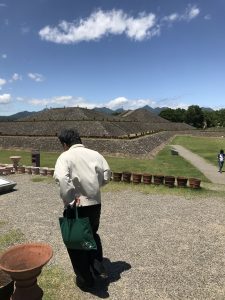
Now another fun one for the history fanatics out there, on Saturday we went to view several of the large burial mounds that can be found throughout Japan. Due to the centralization of the country during the 3-7th centuries, elites from the more distant regions began to copy the tomb building style found in the capital region of the country. These tombs are in the form of massive keyhole-shaped mounds. It is interesting to note that these mounds were not erected for the burial of many different people but were for one or two people. This indicates that the highly hierarchical system found in most other parts of Japanese history, especially during the Edo period and still can be seen today, was found in the earliest era of Japan.
Research Project Overview
The full title of my research project is “Fluxoid Dynamics and Electromagnetic Properties in Fore Front Superconducting Materials.” Type-II Superconductors are able to carry current with almost no resistance when kept below a critical temperature, current, and field. While the issue of increasing the critical temperature is one of the most pressing research topics in modern times, increasing the current load that can be handled is also incredibly important if superconducting wires are ever going to be used for larger applications like power cables. This increased current carrying capacity can be accomplished by integrating nano-technologies into the structure of the superconductors. I believe that my specific project will be testing the properties of one of these materials.
Being able to model the behavior of superconducting wires is incredibly important before they are used in practical applications such as powerlines for DC electric railways. In particular, the effect of a fault in a superconducting system on its functioning needs to be determined to ensure that superconducting wires are resilient enough for real-life use. While the behavior could be approximated by numerical simulation, the accuracy is limited by an imperfect understanding of the mechanics of superconductivity. To combat this problem, researchers at the Kiss lab created a digital simulation of the loads that would be applied by two electric trains across a DC power supply and scaled these loads to be applied across a considerably smaller superconducting wire. The voltage and current that resulted through this wire was fed into the digital simulator every 50µs allowing for rapid response and an accurate understanding of how a superconducting wire would cope in real life situations. This experiment was successful in two aspects, primarily it demonstrated that the digital simulator and experimental setup could be integrated to model real life conditions that would be difficult to model with numerical simulation. Secondly, the effectiveness of a fault current limiter (FCL) was proven when a fault was introduced into the model. It is interesting to note that the FCL was made more efficient by the sharp rise in resistance within the superconducting wire when the current exceeded the materials Jc (critical current).
Week 02: Language Learning and Trip to Mt. Fuji Lakes
Studying only Japanese every day has definitely allowed me to speak more Japanese than I ever thought was possible. I think the most satisfying part of Japanese so far is steadily gaining an understanding of the grammar. The class is oriented to teach “survival” Japanese, so the actual amount of grammar we have been explicitly taught is pretty minimal. However, from context and learning several sentences I think my understanding of the basic grammatical format of Japanese has grown. I do think that this type of teaching might be beneficial in the short run, but really detrimental in the long run because it doesn’t really set us up to improvise in Japanese. While we can learn the basic structures on our own, normally these are the more complicated concepts and it would’ve been helpful if the class had been taught more traditionally for that reason.
The interview at the AJALT office was probably one of the most frustrating experiences I have had with my Japanese because it felt as though I reverted to almost zero Japanese knowledge. It is pretty frustrating to go from relatively confidant with the material in the classroom setting to trying to talk and basically speaking in Spanish the entire time. While the vocabulary is proving extremely difficult to obtain, it is also difficult to think in such a drastically different word order.
I think that my realistic goal for my Japanese learning is to just be able to understand most of what is said to me at restaurants and konbinis and be able to respond in turn. If I can do that, then I will feel confident enough to return to Japan in the future. If I can be a dreamer, I would like to be able to have a casual conversation with a friend in Japanese, but I think that may be a little beyond my feeble language acquisition skills.

Over the weekend we visited Fuji-san with the 2018 Japanese Nakatani Fellows. Mount Fuji, was certainly as awe inspiring as the many artistic portrayals of it attempt to show. Its great potential for destruction resulted in the creation of several hundred temples around the mountain, that all attempt to pacify the deity of Mount Fuji. At one of the temples we visited, these absolutely massive trees were all over the place, with one growing basically into the building. At this same temple, there was a shrine where the traditional beginning of the route of Fuji begins. Gavin tells me he plans to walk from to the peak playing a lute all of the way. I told him I would memorize the Odyssey and sing it with him as we hike.
At the 5th station of Fuji, we got some soon-to-become very annoying bells to commemorate our visit. However, Sarah saved the day by suggesting we get an ice cream flavor unique to the mountain. I would recommend. When we finished for the day we headed to the strangest hotel I have ever been in. Basically, we stayed in some above ground hobbit hovels in a pseudo-Disneyland. They also had this crazy water show at night where they were able to get water 30 meters in the air. The show itself was a little tacky, but I would recommend because of how astounding the mechanics of the show were. While there were some kids in front of us, oohing and awing, my entire row was nerding out discussing how complicated the program must be to run the show. I mean every faucet had 2-dimensions of motion, and there were at least 15 different arrays of faucets, plus laser lights had to be coordinated with the whole thing. Another mystery was where on earth they were sourcing so much water pressure, no one could hear a pump and as I said before they had all the fountains at full blast for extended periods of time.
Just like the first day with the US fellows, it was pretty hard to start talking to the Japanese fellows, and even at the end of the weekend we were still pretty separated. While there were exceptions, I think it is hard for us to break up our cliques. However, I will say that the onsen worked its magic again. On Saturday evening, almost all of us went to the onsen, and luckily it was super nice and large (there was a whole boulder in it) because there were a lot of us. We did two truths and a lie in the onsen which was pretty funny, but because it took super long we were basically all standing in the pool at the end. I think we also scared everyone else in the bath away because we were loud in a classic American fashion, but it was worth it because I think the guys ended up mixing more than the girls by the end of the program. I don’t know if this is entirely due to the onsen, but no one can prove it isn’t.
I would like to give one shout out to my boy Ryotaro who taught me that it’s okay to eat literally every part of not only a shrimp (I mean shell, head, and tail) but that you can eat all of a fish too (yes, the little bones, the spine, and the skull). I ate the shell of the shrimp and it wasn’t too bad, but I didn’t have the spine to eat the spine of the fish. This is probably my next goal in Japan.
Week Two Overview
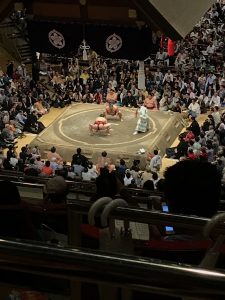
On Tuesday we visited JAMSTEC to learn more about both their supercomputer and the extensive work JAMSTEC does in marine research. While we didn’t get to see the supercomputer, the noise that the cooling mechanisms made was impressive enough. It was interesting that the entire storage unit for the computer was built on top of an earthquake proof platform, although the analysis building wasn’t; making me wonder how good a computer is if all of the monitors are destroyed. Also, I was thinking how awesome it would be to work for JAMSTEC during this summer (future Nakatani place???) because you could do research on a boat the entire time and maybe drive a submarine.
Much to the dismay of Sahil and Kenneth, I took a class on Tokugawa Japan in the spring and I was going to tell them everything that I knew as we walked through the Edo-Tokyo Museum. It was really funny to go through the museum and see objects that had been put in my professor’s power-points like the night soil carrying device. I can’t be 100% certain, but I believe that this one gold covered screen that depicts Edo is only displayed twice a year because it is such an important national treasure. If that is the case then we were extremely lucky! It was also interesting to see many of the recreations of Edo pre and post Meireki Fire. This fire is attributed to a priest who burned a supposedly cursed kimono that had killed all of its previous owners, but kimonos are light and it floated away to burn down most of Edo.
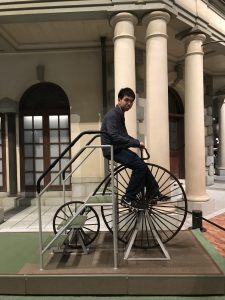
On Friday we had a talk from Professor Shimizu-Guthrie on the topic of baseball in Japan. I think one thing about this lecture that I found incredibly interesting was that the relationship between Japan and America was so amicable almost until 10 years before WWII. Many baseball teams were sent over to Japan to tour, and baseball was really blowing up as a sport right before the war. Professor Shimizu-Guthrie argued that this is why America and Japan were able to become such strong allies immediately after the war. It is shocking that, although America was incredibly successful at introducing baseball and occupied Japan for several years, there are still so many striking cultural differences that exist between the countries.
Question of the Week
I’ve heard that Japanese College is easier compared to basically every other level of education, why is that?
- Japanese College: The Spring Break of Life (Tofugu)
- For more on this, see the Education in Japan section of our Life in Japan resources page.
- The structure of university life in Japan is also greatly informed by the hiring practices of Japanese companies, particularly for entry level employees. For more on this, see the section on ‘Job Hunting in Japan’ on our Career Resources for S&E Students page.
Introduction to Science and Engineering Seminar
The first talk we had this week was from Otsuji-sensei from Tohoku University, who talked about tera-hertz technology. Admittedly of all of the talks that happened this week, I think this one went the most over my head. I still found the talk immensely interesting, mostly because my lab back home predominately studies the terahertz region (although my research was mostly unrelated). I had never really heard any of the potential application of terahertz, such as greater data conveying capacity than traditional lasers. This lecture was also interesting because it delved into the properties of graphene and its possible use in the generation of THz laser beams.
The next talk we had was from Saito-sensei from Tohoku University. While his topic was just as complicated, I think he did a little better job at simplifying the material for a less experienced scientist. I’m pretty psyched about space travel, so carbon nano-tubes (CNTs) are super interesting for their possible applications in a space elevator. Not to go on a rant, but if we can get a functional space elevator, we can build a galactic fleet relatively inexpensively in space in almost no time (and finally find TMA-2 orbiting Saturn).
Finally, we had two talks from Kono-sensei from Rice University that tried to give a rapid introduction to both basic quantum theory and recent developments in solid state physics/materials science. In the realm of solid state physics, he went pretty deeply into bandgap theory: discussing k-space, indirect/direct bandgaps, heterostructures formed by combining these types of semiconductors, and very briefly hinting at valleytronics. He presented the interesting contrasting effects of quantum confinement on light in quantum dots vs resonance due to plasmonics in metals like gold nanoparticles. I think the most interesting part of the lecture was on possible future computing methods using particle spin, atomic energy levels, or cooper pairs (although the latter was only mentioned). The lecture didn’t really delve into superconductors, but for the most part there haven’t been transformational discoveries in high temperature super conductors for a little bit (although I did just read something about superconduction between two graphene sheets oriented at a slightly different angle from one another).
Week 03: Noticing Similarities, Noticing Differences
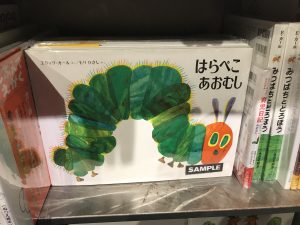
Using public transportation in Tokyo is pretty essential if you want to get anywhere, but it also makes it possible to get almost anywhere. While the transport is incredibly convenient, there are many rules that can make it a little awkward at times. During the busier times of the day it is important to either put your backpack on the ground in front of you, or on the front of your body so that you know you aren’t knocking people over with your bag. At night it is pretty taboo to talk on week days because most people are sleeping, but sometimes you will see people doing it quietly. Talking loudly is always bad manners, but sometimes Americans get excited when we talk and get mad stares from the locals. I learned from a recent experience with Grace, apparently some older gentlemen don’t approve of people crossing their legs on the subway. Nobody on the trains is ever eating or drinking anything and as a result the trains are very clean. This is pretty different from the US where food and trash could be everywhere, also it generally doesn’t smell bad which is a drastic departure from US public transport. I think the respect that is shown for others and the actual physical system reflects the collectivist nature of Japan where common goods are taken care of. However, if you travel late enough at night with the stinking drunk salarymen you get to see another side of the Japanese society.
Orientation Program in Tokyo: Week Three Overview
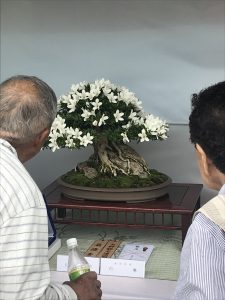
On Monday, I went exploring with Grace, Ellen, Gavin, and Hana. We ate lunch in Ueno park where for the first time in Tokyo a Japanese man actually approached us with his wife to talk about America. We then went to a museum, which was closed on Mondays….. Luckily right outside of the museum was what seemed to be a bonsai tree competition, which was probably the last thing I expected. It was interesting to see the trees that were selected because many of them were not beautiful in the traditional western understanding of flower arrangement. They were more asymmetric and more spindly in some cases. I was particularly drawn to the tiny trees that had massive trunks because I thought they looked nonsensical, but also ancient.
On Wednesday, Kaitlin and I went to the Ishikawa Brewery to learn about the history and science of sake brewing. The brewery was started after the Meiji Restoration and is about an hour and half away from the Sanuki Club. The actual process sounded very interesting, but sadly the actual production of Sake only takes place in the winter, which meant the facility was basically abandoned. It was also sad to learn that the processes which used to take 30 people now only takes 4 because of computer automation. I thought it was really interesting to learn the difference between cold and hot sake. Cold sake must be kept cold because the yeast is just dormant in the sake, and if you heat it up; you kill the yeast and possibly activate harmful bacteria in the sake. The cold sake is also more alcoholic because the yeast has been kept in the sake to turn almost all of the sugars into alcohol. Finally, I got to taste some of the final product, which rounded out my appreciation of the sake.
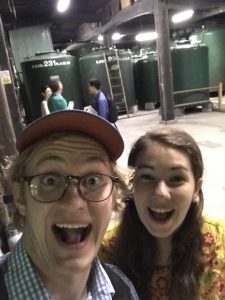
We had some interesting talks this week from various speakers. The first speaker, Professor Nishikawa, focused on the philosophical origins of science in the beginning of his speech. He finished off his talk by saying that the future of life-sciences will likely be very influenced by the mass collection of data. I was intrigued that he didn’t extrapolate that to using AI more in medical treatments. Our second talk was from Kento Ito-san who told us about his project to increase the use of kimonos throughout Japan, and more generally to encourage the revival of Japanese tradition. His speech was very interesting, and he seemed really impassioned about spreading Japanese culture. Also, the 2020 Olympic kimonos were super cool. He didn’t seem to know about the concept of cultural appropriation, which I think might be hurdle he will encounter if he travels to America again. Finally, we had a talk from Ozaki-sensei that instructed us on how to properly visit someone’s house. She also clarified some of the finer points of gift giving that I was confused about, like what to say when handing off the gift.
The last week of language class has been focusing on the production of a final speech, which I think is a little bit of waste of time. The idea probably was to get us to review everything that we learned and use it to create a long speech. While this could potentially be helpful for the higher classes which have learned more material, it was difficult to write anything with the limited grammar we had. I think a much more useful exercise would be to spend the last week reviewing all of the material that we did learn and solidifying it. I imagine going back over the stuff we learned at the beginning (which was basically gibberish at the time) with our greater understanding of the language would have etched the material more firmly into our brains. I think the only plus side to the speeches was that we got to hear Lincoln talk about NaruNaruNaruNe for 5 minutes, which was brilliant. If science doesn’t work out for him, he could certainly be a salesman.
Introduction to Science Seminar
Professor Stanton gave a quick overview of many material science topics. One topic of his lecture that I found extremely interesting was the creation and control of potential wells in a semiconductor. This helped with my understanding of the cascade laser system. Another topic that I found interesting was the nano-seismology. I have never really thought of soundwaves on an atomic level in any medium besides a gas, and the concept of a phonon is relatively new to me. This being said I had definitely never thought about the difficulties of analyzing the internal structures of nanosized materials. Using normal spectroscopic techniques either limits you to purely studying the surface or being only able to study the material as a conglomerate with no sense of how its properties change with depth. However, using ultrafast spectroscopy and phonons basically as sonar, one can understand how the structure of an object changes with depth.
Dr. Futaba’s in-depth speech on carbon nanotubes was interesting because of his proximity to industry. While there has been considerable talk about the applications and amazing properties of carbon nanotubes, it was nice to hear about the actual production methods and the problems that still face carbon nanotube production. I think one of the biggest problems that he presented was the inability to select for chirality in the production of the tubes. He did say that the tubes could be later sorted, but the length of the tubes after this process is severely limited. The actual understanding of what happens in many reactions and catalytic reactions is normally pretty limited, and only recently with ultrahigh speed spectroscopy has experimental data been provided to really understand the mechanisms. This is why it isn’t particularly shocking that a firm theory explaining nanotube growth hasn’t been developed. This talk also made me think about ways one could generate nanotubes, which I think shows that the talk was really engaging.
The final speech we received this week was from Professor Ishioka. Her research into ultrahigh speed spectroscopy was interesting and highly related to what Professor Stanton was talking about. She also talked about her experience working in the heavily male dominated Japanese science sector. It was disheartening to see that the statistics for female participation in the STEM research and study haven’t really increased from her time at school, especially when she said scientific research is one of the most liberating professions woman can have in Japan.
Question of the Week
Why do the bento boxes always have spaghetti included in them?
- Check out our Food in Japan page for more on bento boxes and culture in Japan and the various types of bentos you may want to try over the course of the summer.
Week 04: First Week at Research Lab
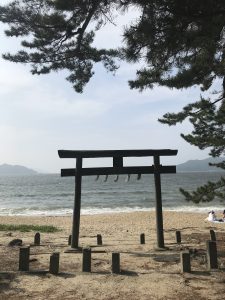
I traveled on the Shinkansen for 5 hours to reach Hakata. From there I took the confusing JR line that is actually a subway line that turns into a JR line by the time it reaches the Ito campus of Kyushu University. Unfortunately, my phone was unable to send text messages to the Lab secretary who was supposed to pick me up at the final stop, but somehow I was able to send her an email. My advice for anyone coming this way again, is to make sure your phone works beforehand and to ship your bags so they arrive the day after you get there. The Ito Harmony House is the furthest dormitory away from the campus, about an extra kilometer. While the room is pretty large (17 m2) and you get your own bathroom, it comes with absolutely nothing for the kitchen. No cups, no pots, no utensils, also the air-conditioning doesn’t seem to work either (however at least you get to believe that you will have air-conditioning which is much more than most can say). The area around campus is completely deserted, it takes about an hour to walk to the closest grocery store, unless you want to harvest some rice from the hundreds of rice paddies that surround you. If you make the trek for an hour, you will find yourself in one of the furthest suburbs from the actual city of Fukuoka, which is just a suburb with a large pachinko parlor (although it does have a pretty massive AEON mall, which sells food and cooking devices). Note on cooking devices the stove is induction, so only buy pots that work with induction stoves.
The first day in the lab, I met Kiss-sensei, and he gave me a little overview of the material I would be studying. Next, I attended a lab meeting, which was in Japanese so I didn’t glean all that much. For the rest of the week excluding Friday I basically did nothing but sit at my desk and read past research articles and a textbook on superconductivity that I found online. I’m not really sure who my mentor is or whether or not I will have one, but I think that my project will start sometime next week. On Friday I helped with cooling an apparatus and preforming several scanning hall microscopy probe tests on an iron based super conductor (which is cool because of their super high critical field, which would allow them to be used in incredibly powerful magnets that dissipate much less heat than bitter magnets).
Most of the people in the lab are pretty reluctant to speak any English, and I’m pretty much unable to speak Japanese besides saying that “I like soccer.” However, the two people I think I am working with are able to speak English well, although we do pull out google translate often.
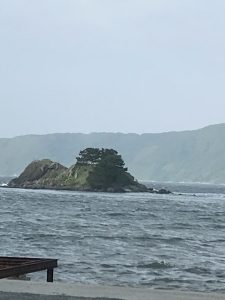
Before everyone leaves this report feeling depressed, I would like to say the solution to basically every problem presented is getting a bicycle. I got a bicycle on Saturday and it has transformed my life already. While the area south of campus is lacking, if you head to the coast (to the east) it is stunningly beautiful. There are miles of beaches and biking paths to go along the coast. The warm smell of pine mixing with the smell of the sea was absolutely amazing, plus there was this one peach tree hanging over the bike path that smelled great too. It takes about an hour to bike into Fukuoka if you just stick along the coast, but it really is so pretty. Also, there are a ton of mountains that you can hike, which are within running range, but who wants to hike a mountain after running? I know you think you will never run into a snake while hiking, but maybe seven minutes after going on to a really lowkey trail and being harassed by a crow who wasn’t happy about my presence, I nearly stepped on one that was in the “about to strike” position. I don’t know what type it was, but it had an angular head. If you are into climbing, I have just gotten a membership at a gym that is about a 10-15 minute bike ride away from campus in Yokohama, and I think that I might be able to get someone there to take me climbing outdoors. I may have also found a kayak rental place, which is perfect because there are so many weird islands sitting just outside of my comfortable swimming range (mostly because I don’t want to get stung by a jelly fish or scare a puffer fish, which I have seen tons of their bodies discarded on the ground in local fishing spots).
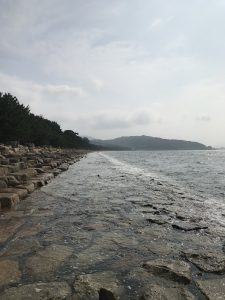
I don’t really have any updates on my project beyond what I have put in the past reports. I have been trained to handle liquid helium and now I know how to use a scanning hall probe to determine current density, but in both of these tasks I would still need a fair bit of help to really do anything (everything being in Japanese doesn’t exactly simplify the process). I think that I will start working on my project next week. Kiss-sensei has some lectures planned to teach me more about superconductivity.
Reflections on Orientation Program in Tokyo
The orientation program was pretty great because I now have a support network in the other fellows. Also knowing some Japanese is definitely better than knowing no Japanese. I think the program introduced me to many of the frustrations that I would encounter later, but in an environment where other people were dealing with the same problems. This was helpful because it makes you feel less alone when someone else is struggling to say they don’t want a plastic bag for every item they purchased at a konbini. During the orientation I also learned that if I want to do something then I should do the exact opposite. Throughout the orientation whenever I wanted to take a certain street and was outvoted by the other people in the group we always ran into something amazing (like golden chicken altars). I think I tend to choose the fastest or least fun way to do a lot of things, and it is important for me to try and fight my tendency to sit in bed and watch Netflix. I want to get out and eat all of the food and hike all of the mountains, but the allure of sitting in bed and watching English TV will be an ever-present temptation.
Question of the Week
Can I climb on mountains? What if they are sacred?
- There are three holy mountains in Japan, but many mountains may have shrines on them at the top or temples along the way. If there is a path/route, it is fine to walk/hike along that and as long as you are being a respectful hiker (e.g.not littering) you should be fine. It is best to not hike alone, unless you are in an area where you will regularly pass other hikers along the way. If you are doing a solo hike of any sort, be sure that someone knows your plans and when you anticipate being back home. These are typical safety precautions all hikers should take just in case they encounter wildlife, fall/injure themselves, or get lost. Even a twisted/sprained ankle can make it very difficult to get back from your hike depending on where you are. Japan is also home to venomous insects, poisonous snakes, and wild animals that can be dangerous when hiking (e.g. wild boars) so this is another reason it is good to not hike alone in remote areas.
- For more on hiking, outdoors, and insects/animals to be aware of in Japan, see the Sports, Outdoors and Working Out section on our Life in Japan resources page.
Week 05: Cultural Analysis – Life in Japan
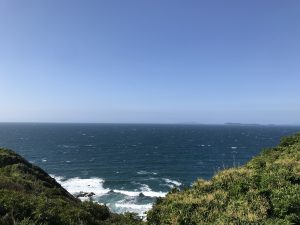
For the last week, I have been able to go to a climbing gym about every other day, and the owner there is absolutely hilarious. I think he has been trying to learn English just so that we can talk when I show up. He speaks a little more English than I speak Japanese, but that isn’t really saying much because I speak practically no Japanese. It is funny because we will talk about the most mundane things, but it will take 15 minutes to articulate it to each other. One skill I have really perfected over the past month is charades. I probably look like a crazy person trying to demonstrate driving a car, or my favorite is when I demonstrate that I take a plane to get from Memphis to Yale (because I look like a three-year-old holding out his arms and running in circles trying to fly). The owner is a little less willing to go full charades, but if he is trying to show me an ab workout or some silly spinning thing that looks cool but isn’t a practical workout he doesn’t hesitate to try and then laugh at me when I fail to do it (“dozo dozo”). The first of the two funniest conversations we had so far was about how I need to eat less chocolate, and every time I fell off the wall after that he would scream “chocolato” or “black thunder” while shaking his fist at the ceiling as though it was the fault of some unseen god of sweets instead of my lack of any self-control. The next conversation turned a little more pg-13 when he asked to look at my abs and then he tried to communicate that he also has trouble making getting rid of his “love handles,” which was a strange thing to say because I never said I had that problem…. Anyway he wanted to know what “love handles” were called in English, so I darted about pointing at various handles on bikes, shovels, and weird climbing chalk scrubbers, and he knew love (which would have been really hard to explain). Once the definition settled in on him, he laughed for about five minutes and kept gripping invisible “love handles” in front of him. I have a sneaking suspicion that this will not be the last time I get a funny story from him.
Research Project Update
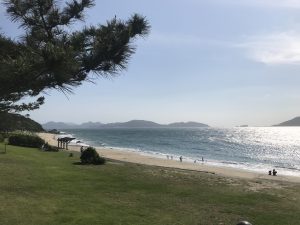
I’m beginning to think that close management and oversight is the policy in this lab because even the M2 grad students have associate professors working with them on measurements. This might be normal for physics labs because generally the equipment is very expensive, and nothing is more expensive than magnets and lasers. I am used to chemistry labs where undergraduates are given a pretty large amount of space to synthesize whatever they need to for their research. This being said, I’m starting to believe that if I do anything it will likely be me helping someone collect data. The way the lab is currently oriented, superconducting samples are sent from China to be tested in Kiss Lab’s scanning hall probe microscope to detect the current density and allow for defect analysis using scanning electron microscopy. These results are then sent back to China, and the tape is corrected in order to fix the defects. I don’t know if the defect analysis is being done anymore in the Kiss Lab because their post doc who did it has left the lab (which is disappointing because seeing the physical causes of flux depinning would be really cool).
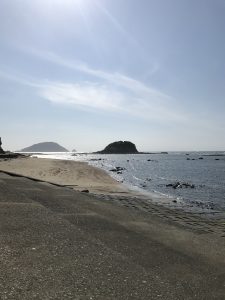
On Monday I am helping test a super conducting joint sample, but this mostly involves me sitting and watching what is happening (which I understand is important for learning, and perhaps I should try and ask more questions about the programming they are using, but it is all in Japanese which is pretty intimidating). I have been told that I might be getting a sample to do testing and analysis on in the future, which sounds promising. Some other reasons I think that my integration into experimentation has been slow is because the tests are pretty expensive (liquid helium costs), they take at least 2/3 days to prepare, and the samples are produced by a separate lab (which means they are limited). These factors combine to make it pretty impractical for me to do dummy runs of old samples (a waste of money) and make it dangerous to let me test new samples (they are valuable). I have found that the large amount of down time that I’ve had is pretty nice in that I am able to pursue a lot of things that I normally don’t have time for (for example I am learning Python, reading about super conductors, and reviewing my linear algebra).
Week 06: Cultural Analysis – In the Lab
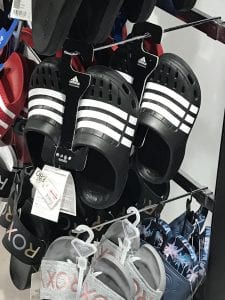
My lab participates in a softball competition every year, and as a result they have softball practice every Tuesday. So far, we have only had one practice because it has managed to rain just about every Tuesday… However, at this one practice I think there was a funny inversion of stereotypes. I had never caught a baseball/softball in a baseball mitt before, nor had I ever used a baseball bat. This was a slight shock to my lab mates who I think expected the American to be a baseball fanatic. Luckily, they were all very nice and I learned that you don’t catch the ball in the palm of your hand when you use a mitt. And before they ended practice they held a private batting workshop with me, where after they taught me how to swing a bat (I was trying to use it like a golf club at first) I think I hit a couple home runs. This really reminded me of the video we watched in the beginning of the program with the kid jumping the pole vault thing. I had given up earlier trying use the bat because I felt bad wasting others’ time since I had no idea what I was doing so I just let the next person go. In the end though, the group supported me and made sure I completed the task. I don’t know if we are going to win the competition, but I can tell you right now that I am going to try waaaay too hard.
I think my biggest personal achievement isn’t one moment, but I really like to see my steady progress at the climbing gym. The style of climbing at this gym is very different than what I’m used to at my gym. Everything seems to require more balance and more of a focus on sloper holds, which in simplified terms means its more competition oriented than what I’m used to. However, I was able to complete, I think, all of the climbs at, what was at the beginning of this program, a grade I could barely start. I think my biggest personal challenge so far is the isolation. This weekend I kind of broke down and played childhood video games until like 4 in the morning instead of going out and doing stuff. It is slightly easier to be isolated by yourself than in a crowd of hundreds of people. I feel better though, unfortunately my bike tire is flat, so I will have to waste an afternoon fixing that when I should have just done it on Sunday.
Research Project Update
Last week we conducted scanning hall probe microscopy (SHPM) testing on a superconducting joint between a low and high temperature super conductor (this high temp conductor is also very resistant to high magnetic fields). The combination of these two types of superconductors can make much cheaper and smaller strong magnets for MRI or particle accelerators. While the joint had been tested before the results were inconclusive because the joint was very 3 dimensional (it maybe had a depth of 15-20mm). SHPM only really works in theory because we assume the conducting surface is two dimensionally. This is a factor of the current being constructed from the magnetic field detected by the Hall probe, and the equation only has a definite solution for a two-dimensional conductive surface.1 In order for the results to be more conclusive we needed to shave off a 2 mm portion of the sample to test using a diamond wire cutter. Unfortunately, the polymer cube that the joint was incased in was not level, which would have resulted in a non-even thickness in the sample, so we used a couple extra layers of tape below one side to make it more level (I am irrationally proud of my one contribution to the experiment). Resulting in a sample with a thickness that only varied by ±.01 mm. The resulting sample yielded much clearer results for the joint (which in this case meant clearer lines defining the current within the joint). I learned a little about processing the one-dimensional data collected from the experiment, which is highly dependent on the height of the probe. However, interestingly the height of the probe is completely unknown, so when recreating the data, a lot of guess work is done to create the best-looking data. As a result, I spent about 3 hours drawing triangles and trying to figure out how to either use interferometry or trigonometry and photodiode to determine the height of the probe. Unfortunately, interferometry requires expensive single mode lasers to be accurate (+ other complications), and the only geometric solution I came up with would have an inaccuracy greater than the measured value. If I could come up with something cheap though, I think the SHPM could be much more accurate.
- Roth, B.J.; Sepulveda, N.G.; Wikswo, J.P. Using a Magnetometer to Image a Two-Dimensional Current Distribution. Journal of Applied Physics 65, 361 (1989); doi: 10.1063/1.342549.
Question of the Week
Why are clothes such a big thing here (not a nudist question, but a fashion oriented one)?
Week 07-08: Overview of Mid-Program Meeting & Research Host Lab Visit
I arrived a little late to the Mid-program meeting because of some difficulties with the bus, but it was okay because I was immediately greeted with all you can eat ice cream. It was really nice to see everyone again, and to be able to speak English with native speakers. Most of my conversations for the last couple of weeks has been about concrete events or actions, and I didn’t realize how much I missed talking about more abstract things until I was about an hour and a half into some crazy talk with Ben and Josh about 2 dimensional beings taking photos of themselves. We got to hang out with the 2018 Japanese Fellows again on the first night in Kyoto. We all went out to karaoke, which was pretty fun although we may have stayed a little too long. Some of the Japanese fellows stuck around for dinner the next night where we learned that eating cookie dough is apparently an abhorrent idea to most of them. Anyway, we got them to promise to at least eat some cookie dough ice cream.
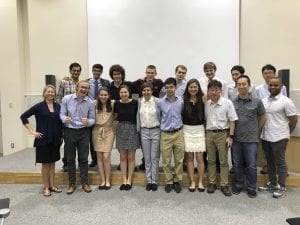
The mid-program presentations I think went well for everybody, and I really enjoyed seeing what everyone has been working on. I think my presentation was a little bit abstract and didn’t really focus on my actual project that much, but this is likely the result of me being pretty unsure about my project. For my next presentation, I would like to focus on my results more. I think this means I will present the materials that I have tested and try to explain what our analysis reveals about the properties of the materials, and how to change the manufacturing process. I think the sample we are testing this week will be particularly promising because it is a very straight forward comparison of the critical current density between several different composition of niobium-titanium alloy. After the presentation we toured a chemistry lab and a biology lab. Touring the chemistry lab made me very homesick. I have only worked in a physical chemistry lab, but seeing all of the chemicals, hearing the venthoods, and touring all of the spectroscopy devices reminded me of how much I miss doing syntheses and creating things.
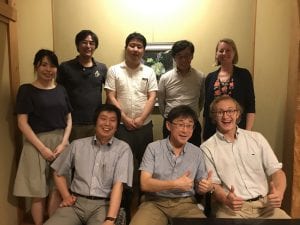
After the mid-program meeting, Kono-sensei, Sarah-san, and Ogawa-san all came to Fukuoka. We toured our lab facilities and saw the facilities of two other labs on campus. The first lab focused on plasma deposition of nanoparticles as well as plasma treatment of crops to increase yield. The next lab focused on nano-structures and an interesting phenomenon known as nano-bubbles. We then went to a traditional Japanese restaurant, which was really pretty and tasty. Unfortunately, Sarah-san and Ogawa-san had to leave before our two other meals (sushi then ramen). The crazy thing was that even after eating all of that food Kono-sensei went to play ping pong. My diet has been messed up since (I’m eating like 2 bowls of ramen every meal). I’m really glad Kiss-sensei took us out to sushi because I was worried I wasn’t going to have the sushi restaurant experience before I left Japan.
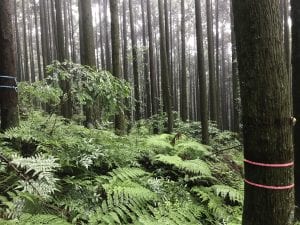
Over this last weekend, I planned to go hiking in some nearby mountains. My plan was immediately derailed when I learned that the train was shutdown due to landslides. Me, being my dumb self, decided to walk to the mountains. While walking in the rain (it rained all day), a very nice Japanese couple pulled over and tried to give me an umbrella as well as warn me that the mountain roads were closed because of landslides. I misunderstood them though and thought they were referring to a specific road (instead of all of them). So I avoided this main road and started hiking in some pretty obscure rice paddies to cut my way onto a separate road. It was maybe only half a mile up this road before I reached the first large landslide (trees and maybe about 5 feet of mud covering the road). Being my dumb self again, I hiked through this getting mud most of the way up my rain pants. This was the first of upwards of 20 landslides I walked through on Saturday.
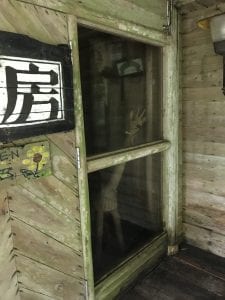
However, I think the height of my adventure was bushwacking through literal jungle trying to follow a trail that literally has no ground markings, and only trees with tape on them or on the ground in front of them spaced apart by 50 meters. I realized a major part of the difficulty with finding the larger trail I was looking for was that the section I was near was completely destroyed and washed away by a landslide. Luckily two more landslides later, I arrived at a completely abandoned campsite/amusement park to eat lunch. After running into a sign that pretty unambivalently told me to stop hiking, I hiked down past an abandoned temple into a beautiful valley, completely covered by fog. Once I reached the valley floor I was given a free bus ride about 2 miles towards Fukuoka. After being told in Kyoto that I couldn’t fill up my water bottle at a restaurant I just ate in, the acts of kindness I received from two total strangers that day really stood out and made me glad I’m in Kyushu. I’m also writing about this because I have just read a NYTimes article of people dying in landslides in the Hiroshima area, and there was an earthquake large enough to wake me up last night, so I’m very happy to have been able to see so many pretty things and get back safe.
Question of the Week
Is there a number I should know specifically for rescues in the woods, or should I just use the normal 110?
- The main emergency numbers in Japan should always work, provided you have cell service, just like 911 in the U.S.
- 110: Police
- 119: Fire, Ambulance, Emergency Rescue
- 118: ER Call to Coast Guard for emergency at sea
- Of course, when calling emergency numbers in Japan the operator will speak in Japanese – not in English. While they may be able to connect you with an English speaking operator depending on when/where you are calling it could take some time. It may also be a bit difficult to convey, in Japanese or English, where you are if you are not on a common/well marked trail. It may be helpful to bring your program guidebook with you which has Japanese/English translations of common emergency phrases that you might need to use (see the language resources section at the back of the book).
- When hiking on your own, it is best to send your hiking route/plan in advance to a friend and schedule a time to call them to check in and make sure they know you made it home safely. If they don’t hear from you by the designated time and cannot reach you, they should then contact the authorities. That is also helpful as a friend who speaks Japanese (perhaps someone in your lab) could also warn you about the weather forecast and any upcoming weather related or other events that might have an impact on your plans. Safety first!
- For more, see the section on Hiking in Japan under Sports, Exercise, and Outdoors section on our Life in Japan resources page.
Week 09: Research in Japan vs. Research in the U.S.
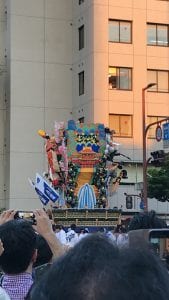
I think I have hit on a couple differences between the American lab I have worked in and Kiss-sensei’s lab in previous reports, but I’ll talk about a couple similarities as well as differences in this report. Kiss-sensei’s lab seems to have a pretty relaxed schedule in that there isn’t really a time that everyone needs to show up. I would say that most people come before 12, but only a few can be found before 10. This is pretty similar to my American lab, because all that really matters is that the work gets done, but the hours are up to the individual. I think people stay in this lab much later than in my American lab, but admittedly I don’t know how long they stay in my home lab in the U.S. because I leave pretty early.
I think a major difference can be found in the social structures of the two labs. Between everyone who isn’t a professor, the talk is pretty casual, but it seems like everyone (M level and Phd students) are afraid of the professors. At my home lab, I would say I think it is more relaxed and I feel perfectly comfortable talking to my professor, and everyone calls him Charlie instead of Professor Schmuttemaer. Another difference I have definitely hit on before is the group effort in projects in Japan. It seems like every task is done by a group of at least 3 people. Last week we were doing an experiment from 9 in the morning until 11:30 at night, and two people who I’m 98% sure aren’t involved in the project stayed until the very end just to sit with my mentor and me. In the US, my experience has been much more solitary, where I would be taught how to do something and expected to do it by myself. Both ways to do things have their merits, for example I have seen considerably fewer mistakes being made with the cooperative system but things tend to take longer. I think this team work idea directly connects to the Japanese core value of cooperation over the efficiency of the American core values. Personally, I prefer the American lab work environment mostly because I like independence and I feel like I’m contributing more to the team if I’m working alone, so that others aren’t tied up doing the same thing I’m doing.
Research Project Overview
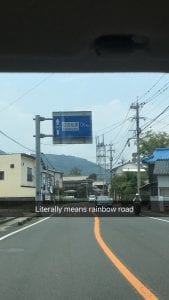
Over the last week I was given the task of analyzing data collected from two Niobium Titanium wire filaments, and organizing a presentation for the group meeting. The data took a while to analyze, partly because the analysis deals with messing with two unknown parameters to get the best-looking result. There are certainly some scientific aspects of the analysis, but other parts make me a little queasy (perhaps I do not understand exactly what we are looking for, but it doesn’t seem super objective). The data was well received, although, apparently I had one of the two unknown parameters very high. My PowerPoint was actually sent to the corporation who created the samples for feedback, which is pretty cool. We are going to analyze two more samples from the same company, but the time line for analysis has been speedup considerably. I will likely have some very late nights in the near future.
Question of the Week
Where is the spiciest ramen in Japan?
- For more on this, see the Overview of Food in Japan section on our Food in Japan resources page.
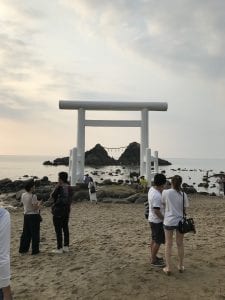
Week 10: Reflections on Japanese Language Learning
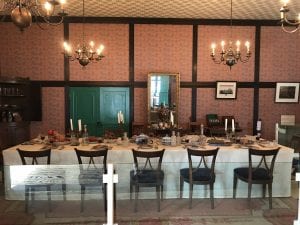
My Japanese has definitely not gotten better since the first 3 weeks, if anything it has probably regressed. I would say that what I can communicate has decreased pretty drastically, but my natural responses in Japanese are definitely better. For example, I don’t hesitate when saying things like arigato gozaimasu or sumimasen, and I’m pretty good at asking where things are. I am a little disappointed, but my lab isn’t super social and the people who don’t speak English don’t really try and talk to me very often. Most of my interactions have been pretty low-stakes, so I haven’t really found myself in that many challenging communication situations. The hardest situation I find myself in, is in restaurants that don’t have an English menu and no photos. This doesn’t happen very often, but it does happen in fancier restaurants. The two ways I have been able to navigate this issue is by either slowly transliterating the words into romanji, or by struggling so much that some Japanese person next to me starts to help me.
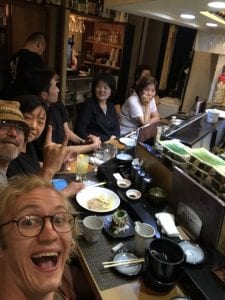
I haven’t done any studying besides kana and kanji reviews since I have arrived at the lab. I haven’t really been that motivated to learn Japanese because after this experience I am not as excited about doing research in Japan in the future. I mean I love Japan, the food, and the scenery, but I can’t see myself working here. I recognize that this could just be the result of being in the lab that I am in, but having no real purpose or work is driving me a little crazy. I have done some stuff, but working 1-3 days a week isn’t exactly what I was expecting. Also, I don’t think the social aspects I expected from working in a Japanese lab have come to fruition, and I am much more isolated than I expected. I wonder how much of this is a result of my lab, and how much is just because I am undeniably a foreigner. I was in Nagasaki this weekend, and made friends with 6 people in an izakaya almost immediately. I have received a lot of kindness from total strangers, free bus rides, free drinks, and almost a free umbrella (but I felt I couldn’t really accept that) among other smaller acts I can’t remember. All of these things were great and I am very grateful to those people, but I don’t think I could stay in Japan much longer without having at least a couple of good friends to hang out with.
Research Project Update
Last week we completed tests on two more samples provided by a corporate partner, and I analyzed the critical current distributions for a presentation to the lab on Thursday. I believe these results and analyses have been sent to the corporation so that they can refine their wire production method. A very interesting response we noticed was that the critical transport current was highest in the samples which had seemingly lower critical current distributions according to our tests. Although, the higher critical transport current samples had more uniform current distributions.
Question of the Week
What are the Japanese laws concerning camping on parks?
- Check out some of the articles under Hiking and Camping under the Sports, Exercise, and Outdoors section on the Life in Japan resources page.
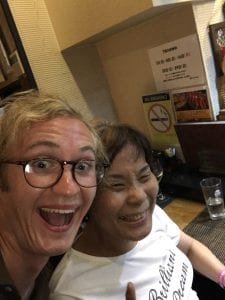
Week 11: Interview with Japanese Researcher
Interview with Zeyu Wu
Field of Study: His major was Electrical Engineering in college, and when he first entered he imagined he would work for a private (he admits that there often isn’t a difference between private and government owned businesses in China) electrical power company. He wanted to work on power grid management. However, when he graduated he decided he needed more education before getting a career. He plans on continuing his education at least until he gets a doctorate.
Perspective on Research in the U.S.: He doesn’t know much about the American education system, but he has heard that graduate students have considerably more freedom in choosing what projects to pursue. He feels as though his project is decided for him by his professors. He doesn’t know much about Chinese graduate school, but he believes it is very similar to the Japanese system.
International Experience: He is an international student, and he is one of the two international students in the lab, both of whom are from China (the other student is the only female in the lab). His limited experience working in a Chinese lab was for a doctoral student, so he doesn’t know if it was really representative of how research is really like in China. His main work in that lab was to help complete the research of the doctoral student. Surprisingly, he doesn’t really think international students are necessary in Japan. His reasoning was interesting as he explained that he felt that Japanese students were just as qualified to do the research. I finally got him to admit that he thinks he approaches problems a little differently than most Japanese students. He will try to solve problems using a variety of computational methods, while the Japanese students may not try using computers at all or will only use lab view to try to solve the problem. He didn’t really think that being Chinese brought anything special to the table in the lab, which I think is interesting because often in the US we talk about how diversity bring new ways of thinking to areas that may have become complacent in their thought processes.
Advice: If he could give advice to himself as an undergraduate, he would tell himself to devote more time to studying programming, information sciences, and math. He thinks that all of these things would have been very useful in research because of how data intensive this research is. He also wishes he studied more English when he was an undergraduate, but I have to say his English is pretty good. His only questions for me have been about how I feel about the lab, and how much I like Japanese food.
Reflections on Interview
I the most surprising thing that Ko-san told me when we were talking was when I asked him why he went to a Japanese university. He told me that for a student of his quality, whatever that means, he wouldn’t have been able to get into a university of equal quality to Kyushu University in China. It just really impresses you with how much the population of Japan is aging, that it is easier to get into a school in Japan than it is in China, and perhaps the US. I just always imagined Japanese schools as incredibly elite impossible to get into institutions, but apparently that is changing. It is also possible that his grades weren’t great but he was able to do well on standardized tests like the admission exams, which may matter more in Japan than China. I didn’t really press him on that.
- For more on Chinese and international students in Japan, see ‘Impact of Study Abroad’ under the Why International Research section on the Intercultural Communication and Skills page.
Research Project Update
We analyzed a barium doped iron arsenide sample from a Chinese university, that proved to be pretty low in quality. The sample was a year old, so there is a possibility that it oxidized as it was not packaged in a particularly protective manner, or it could just be a poor-quality sample. This type of superconductor has demonstrated, in the past, incredibly high current densities in high magnetic fields as well as high temperatures, but the magnetic field generated by this sample at 5 K and 1T was virtually zero. Which is pretty disappointing because it either means that it is still really difficult to manufacture this material well, or it deteriorates pretty rapidly.
Return to Top
Week 12-13: Final Week at Research Lab & Re-Entry Program
Not Yet Submitted
Final Research Poster & Project Overview
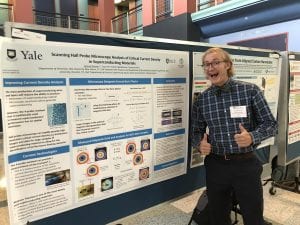
Research Project: Scanning Hall Probe Microscopy Analysis of Critical Current Density in Superconducting Materials (PDF)
Host Lab in Japan: Kyushu University – Measurement and Instrument Lab, Kiss Laboratory
Host Professor: Prof. Takanobu Kiss
Follow-on Project
Not Yet Submitted
Tips for Future Participants
Not Yet Submitted
